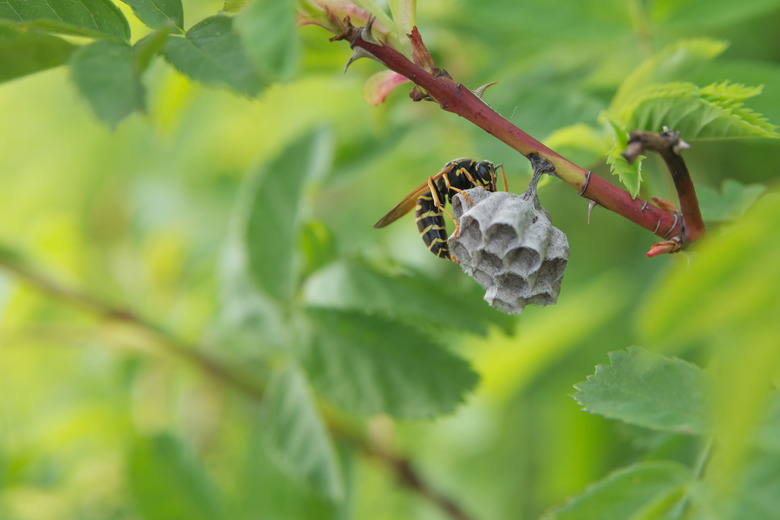How To Identify Wasps Nests
Before you poke the end of a broomstick at that blob of hardened mud stuck beneath the eave of your roof, it might be wise to identify what it is you're poking – unless you don't mind being inundated by angry, buzzing insects that can sting you more than once.
Whether you call them yellowjackets, hornets, mud daubers or wasps, most of these insects can repeatedly sting, as they can pull out their stinger and use it again and again. Most wasps make nests out of chewed up wood fiber that gives them a gray, papery color. Yellowjackets often go to ground for their nests, while mud dauber wasps use mud to create their nurseries.
TL;DR (Too Long; Didn't Read)
Wasps are opportunists and belong to the family Hymenoptera along with bees and ants. They build nests under building eaves, in cavities like the open end of a pipe, on tree limbs, wood beams in attics, garages, garden and wood sheds and any place that provides protection for their young to grow up safely. Most wasp nests appear gray or papery because they build their nests from mud or chewed-up wood fibers.
Yellowjacket Nests
Yellowjacket Nests
Not all yellowjackets build their nests attached to building eaves. Some prefer to go to ground or enter through holes that give them access to attics inside buildings or beneath raised foundations. If you find yellowjackets inside your home, especially after the first frost or freeze of winter, more than likely they have built a nest inside the attic of your home that they access through screens below the eaves or small cracks in the building. If you come upon a ground nest and it's far enough away not to bother the people in your home, it's best to leave the nest alone, as wasps feed annoying insects to their young.
The Different Look of Nests
The Different Look of Nests
Each type of wasp builds a nest slightly different from the nests its cousins build. Some nests have a rounded appearance like a balloon with an entrance hole at the bottom. Bald-faced hornets nests resemble a gray wineglass hanging from the lip of the cup part attached to a building eave. A long cylindrical stem drops beneath the cup of the nest to allow access inside. Paper wasp nests resemble the honeycomb look that bees create with each papery cell supporting a new wasp. Their nests are circular and somewhat flat, no taller than a wasp's length. Mud daubers build small mounds of mud attached beneath eaves that harden to a gray or brown, depending on the mud color in your neighborhood.
The Foods They Eat
The Foods They Eat
Wasps are beneficial creatures, offering some of the same benefits of bees: pollination. Besides pollination, young wasps eat a lot of insects such as crickets, spiders, caterpillars and flies – bugs that turn into pests in your garden or inside your home. Adult wasps feed on sugars in ripened fruits while paper wasps feed on nectars. Some yellowjackets, mistakenly called meat bees, hover around a barbecue and like meat. Late summer barbecues near a yellowjacket nest make for an unpleasant meal.
Cite This Article
MLA
Brenner, Laurie. "How To Identify Wasps Nests" sciencing.com, https://www.sciencing.com/identify-wasps-nests-8235179/. 4 May 2018.
APA
Brenner, Laurie. (2018, May 4). How To Identify Wasps Nests. sciencing.com. Retrieved from https://www.sciencing.com/identify-wasps-nests-8235179/
Chicago
Brenner, Laurie. How To Identify Wasps Nests last modified March 24, 2022. https://www.sciencing.com/identify-wasps-nests-8235179/
